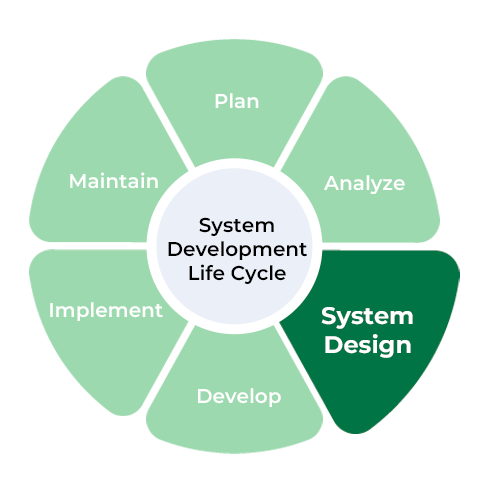Systems Design is the process of defining the architecture, components, modules, interfaces, and data for a system to satisfy specified requirements. It involves translating user requirements into a detailed blueprint that guides the implementation phase. The goal is to create a well-organized and efficient structure that meets the intended purpose while considering factors like scalability, maintainability, and performance.

Why Learn System Design?
In any development process, be it Software or any other tech, the most important stage is Design. Without the designing phase, you cannot jump to the implementation or the testing part. The same is the case with the System as well. Systems Design not only is a vital step in the development of the system but also provides the backbone to handle exceptional scenarios because it represents the business logic of software.
 The importance of System Design phase in SDLC
The importance of System Design phase in SDLC
From the above SDLC steps, it is clear that system design acts as a backbone because no matter how good the coding part is executed, it, later on, becomes irrelevant if the corresponding design is not good. So here we get crucial vital information as to why it is been asked in every Product Based Company.
Below are the main 5 reasons why to learn system design:
- System Design is crucial in FAANG interviews.
- You need to have good expertise in System Design to be hired for Senior positions.
- System Design proficiency enhances job security.
- Understanding System Design will help you to have good communication.
- Learning System Design improves decision-making.
Objectives of Systems Design
Below are the main objectives of Systems Design:
- Practicality: We need a system that should be targetting the set of audiences(users) corresponding to which they are designing.
- Accuracy: Above system design should be designed in such a way it fulfills nearly all requirements around which it is designed be it functional o non-functional requirements.
- Completeness: System design should meet all user requirements
- Efficient: The system design should be such that it should not overuse surpassing the cost of resources nor under use as it will by now we know will result in low thorough put (output) and less response time(latency).
- Reliability: The system designed should be in proximity to a failure-free environment for a certain period of time.
- Optimization: Time and space are just likely what we do for code chunks for individual components to work in a system.
- Scalable(flexibility): System design should be adaptable with time as per different user needs of customers which we know will keep on changing on time. The best example here out is the well-known firm: Nokia. It is the most important aspect while designing systems and is the result of why 1 of 100 startups succeed over the long run, the best example here out is GeeksforGeeks.
 Objectives of System Design
Objectives of System Design
Note: System Design also helps us to achieve fault tolerence which is ability of a software to continue working where even its 1 or 2 component fails.
Now after glancing and going through the above objectives let us now discuss the advantages of system design to understand it better as the below advantages get our understanding even closer to real-life.